This post may contain affiliate links. Please read our disclosure policy.
Turn heavy cream into a rich, thick spread with this small batch clotted cream recipe. With just one ingredient and time, the cream transforms into a luscious topping perfect for scones and pastries. It’s incredibly simple to make and far better than store-bought!

Why You’ll Love This Recipe
- Easy to Make: Just pour the cream into a dish and let the oven do the work.
- Perfectly Portioned: Made for one or two people, so nothing goes to waste.
- Budget-Friendly: Homemade clotted cream costs much less than store-bought.
- No Special Equipment: All you need is an oven and a shallow baking dish
- Versatile: Enjoy it with scones, pastries, or as a creamy topping for desserts.
Clotted cream is a rich, thick cream traditionally served with scones and jam. Made by slowly heating heavy cream, then letting it cool, the natural fats rise to the surface and form thick “clots” that create its signature texture.
This beloved cream originated in Devon and Cornwall, in southwest England, where it’s often called Devonshire cream or Cornish cream. I fell in love with clotted cream during a trip to England, where I enjoyed it the classic way—piled onto a warm scone with a spoonful of jam. Making it at home is surprisingly simple, and the results are just as indulgent!
Enjoy the rich, creamy texture of homemade clotted cream with scones. It pairs perfectly with our small batch cream scones, small batch strawberry scones, lemon scone recipe, or even savory ham and cheese scones.

Featured Comment
“Tried it for the Queen’s Platinum Jubilee with great success!”
– Michelle
Ingredient Notes
Choosing the Right Cream for Clotted Cream
- Heavy Cream: The only ingredient needed for homemade clotted cream. This recipe uses one pint of heavy cream to create a rich, spreadable topping. While most recipes call for regular pasteurized cream, it’s not always easy to find. We tested both pasteurized and ultra-pasteurized cream, and both work—though with slight differences.
- Pasteurized Heavy Cream (Preferred): This cream undergoes minimal processing, allowing better curd formation. If available, it’s the best choice.
- Ultra-Pasteurized Heavy Cream (Works Too): This cream is heated to a higher temperature for a longer shelf life. It still produces clotted cream, though the curds may not separate as distinctly.
Since pasteurized cream can be hard to find, I tested ultra-pasteurized options as well. The recipe photos show clotted cream made with ultra-pasteurized cream, so you can see the results for yourself.
Creams Tested:
- Ultra-Pasteurized Heavy Cream (grocery store brand like Harris Teeter)
- Ultra-Pasteurized Heavy Whipping Cream (local co-op brand like Organic Valley)
- Pasteurized Heavy Whipping Cream (local creamery brand)
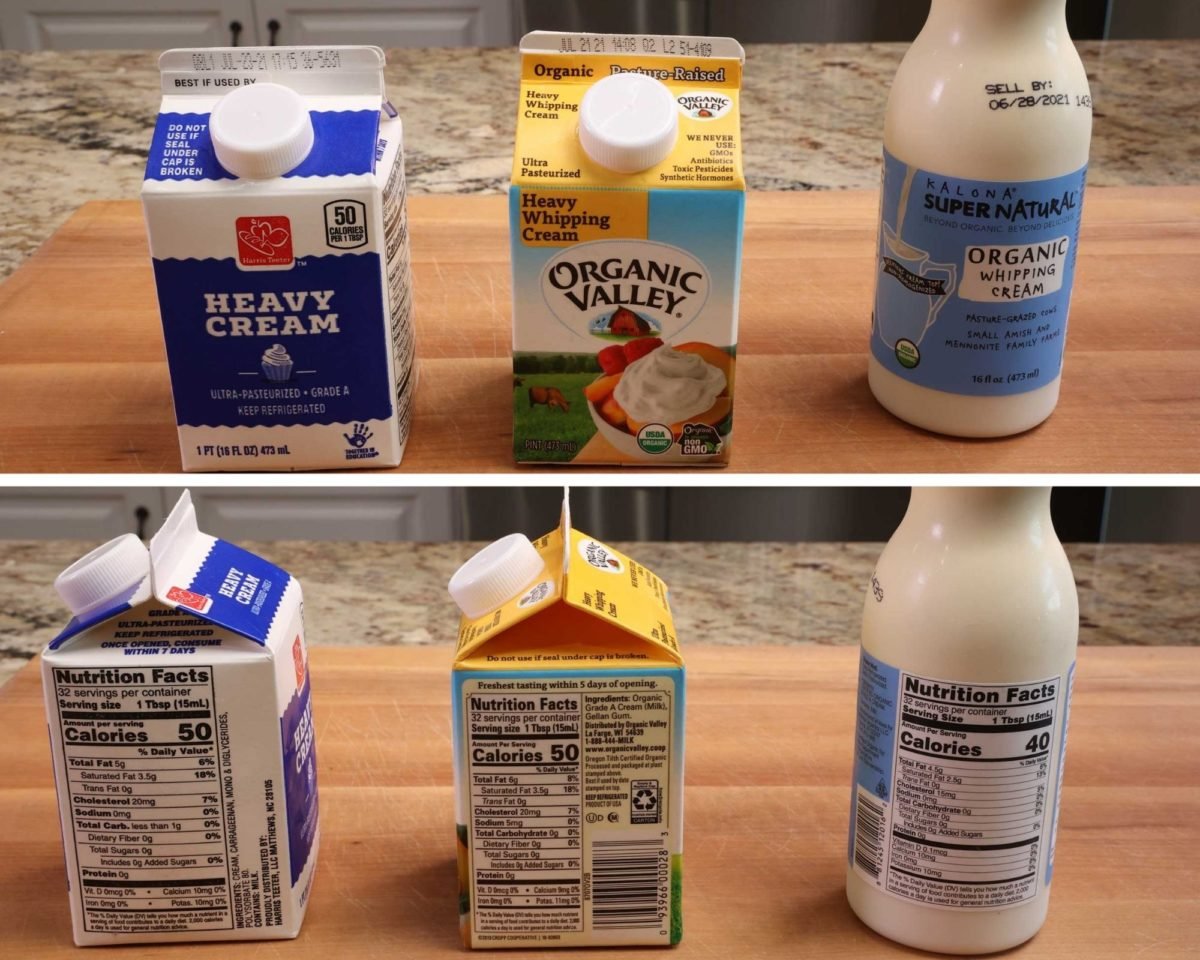
Clotted Cream: Pasteurized vs. Ultra-Pasteurized Cream
From the photos below, you can see that both ultra-pasteurized and pasteurized heavy cream produce similar results. While pasteurized cream is often recommended, ultra-pasteurized cream still works well, making clotted cream accessible even if pasteurized cream is hard to find.
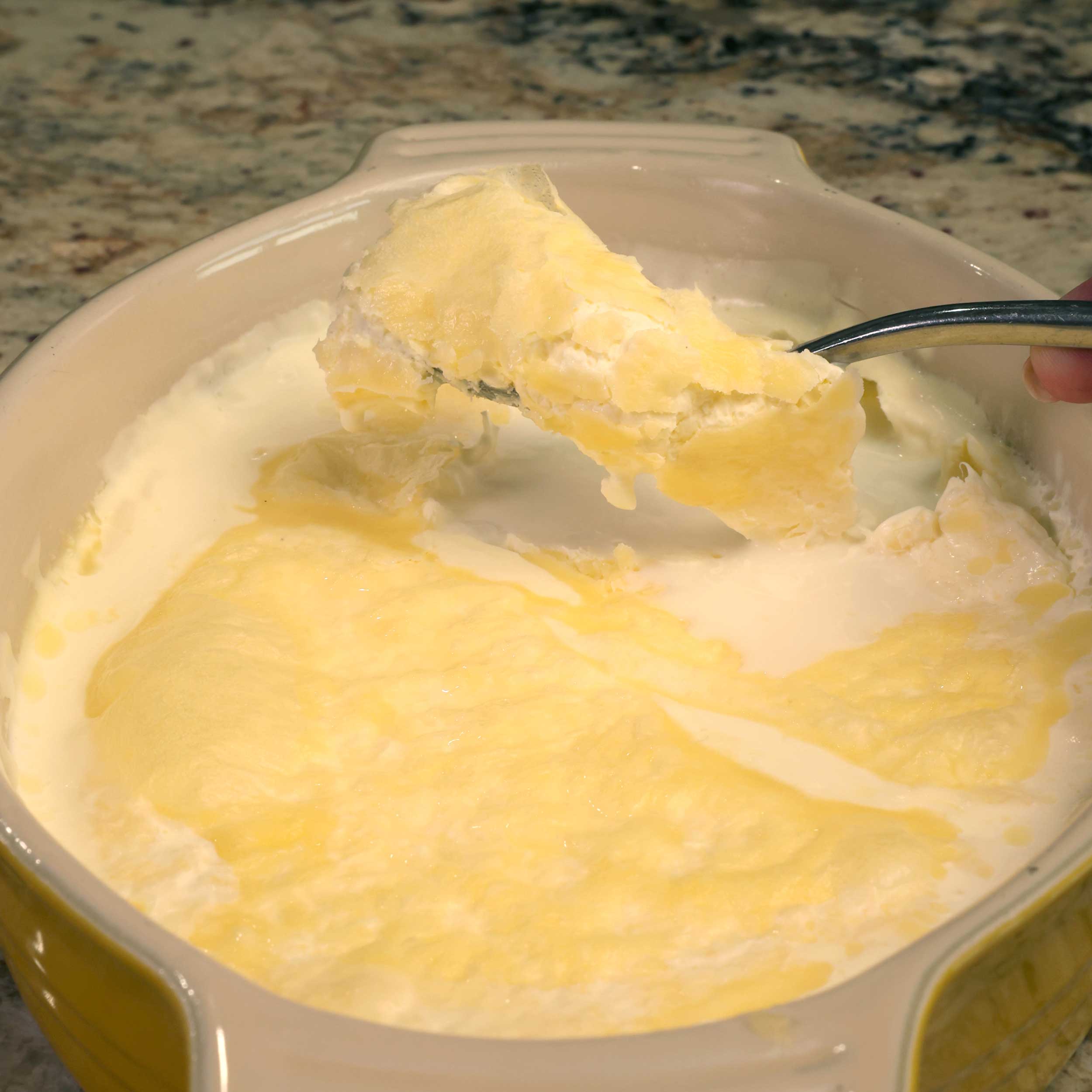
Clotted cream made with ultra-pasteurized cream
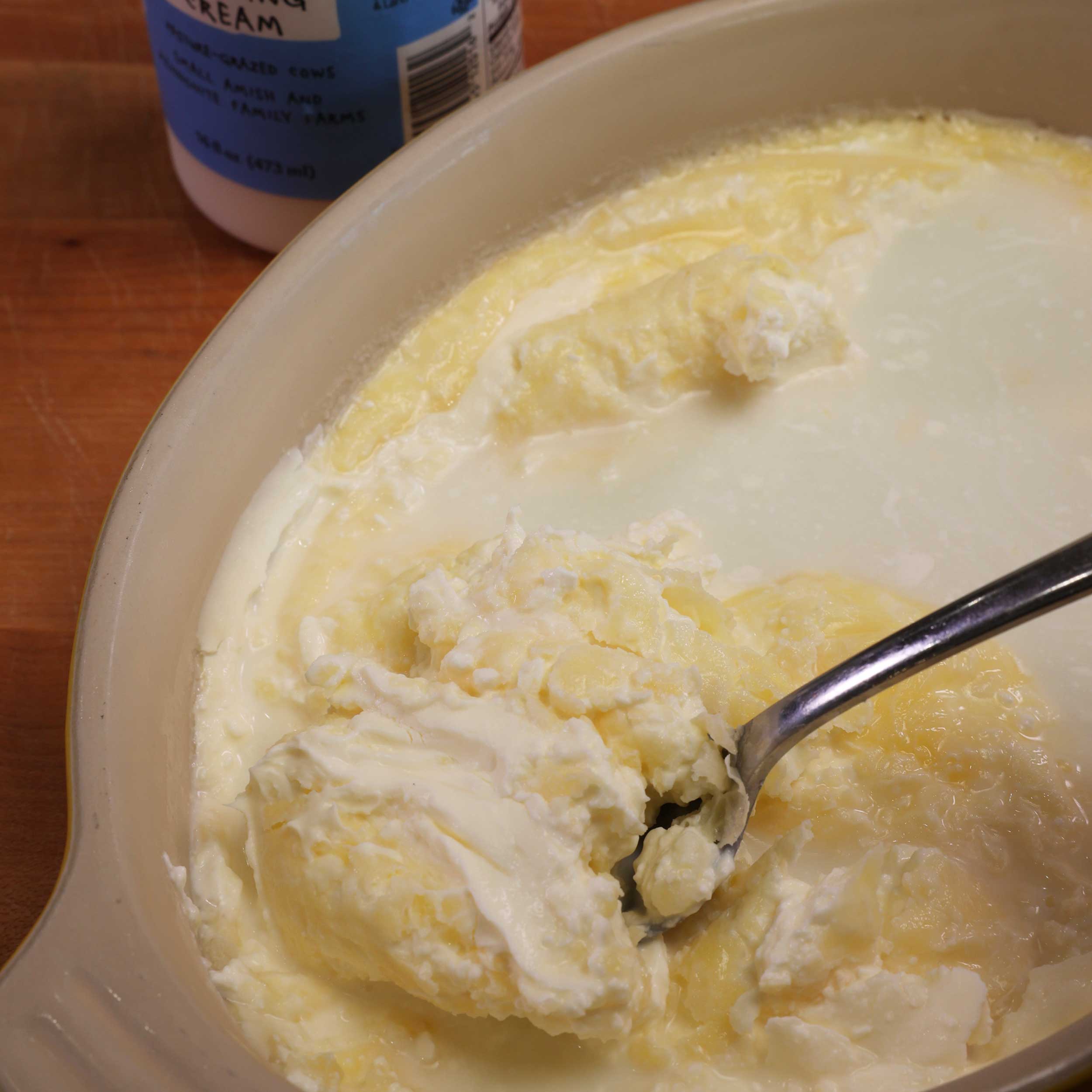
Clotted cream made with pasteurized cream
How To Make Clotted Cream
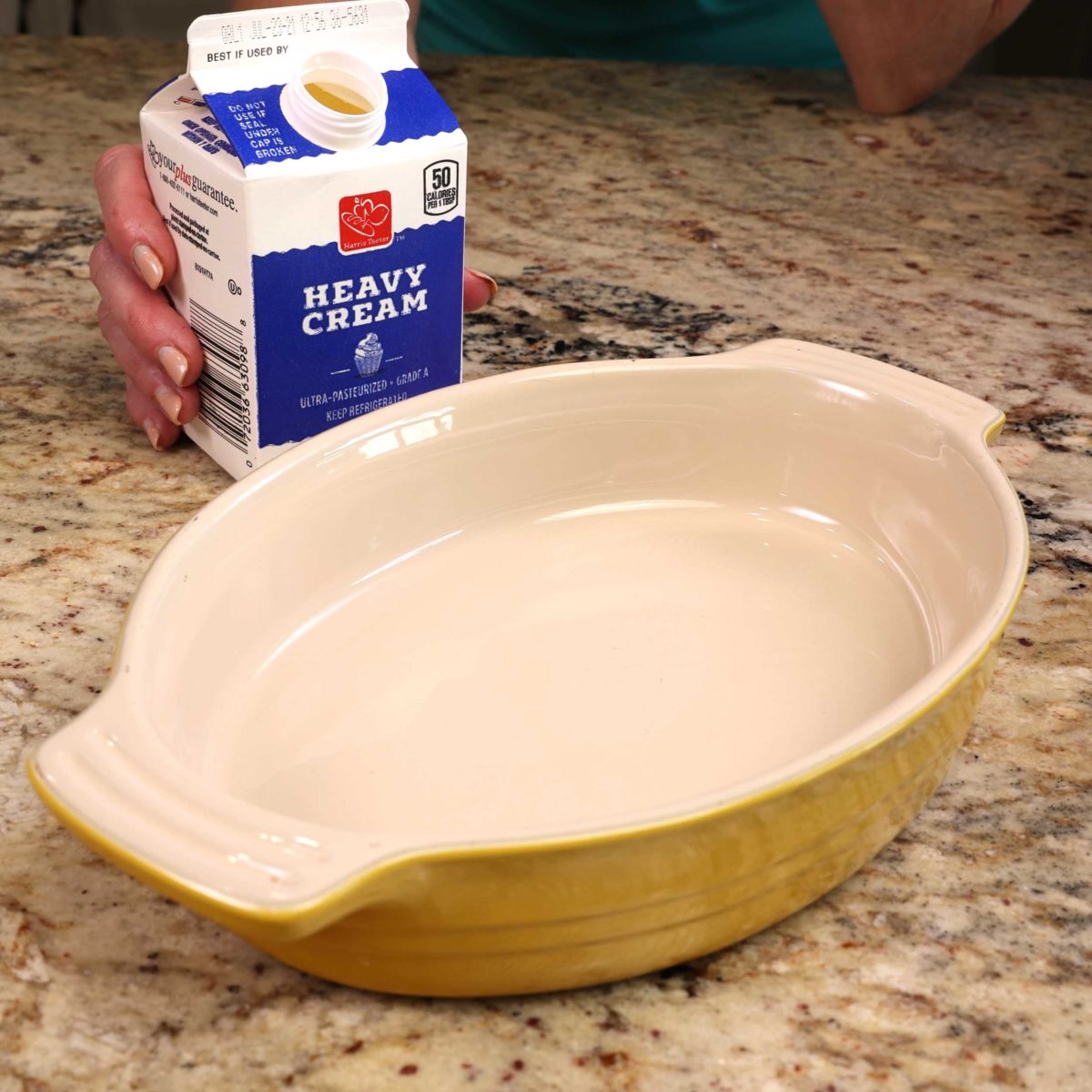
Choose Your Baking Dish
For this small batch recipe, a shallow baking dish is key. A wider surface area allows the cream to heat evenly, leading to the best results. Here are two good options:
- 6×8-inch oval baking dish or a 6×8-inch rectangular baking dish
- 5×7-inch baking dish
Now, let’s make clotted cream!
Instructions
- Preheat the oven to 175°F (80°C). Pour one pint of heavy cream into an 6×8-inch or a 5×7-inch oven-safe dish and place it in the oven. Bake for 12 hours—this works well overnight.
Important: Some ovens shut off automatically after several hours. Check your manual and set an alarm if needed.
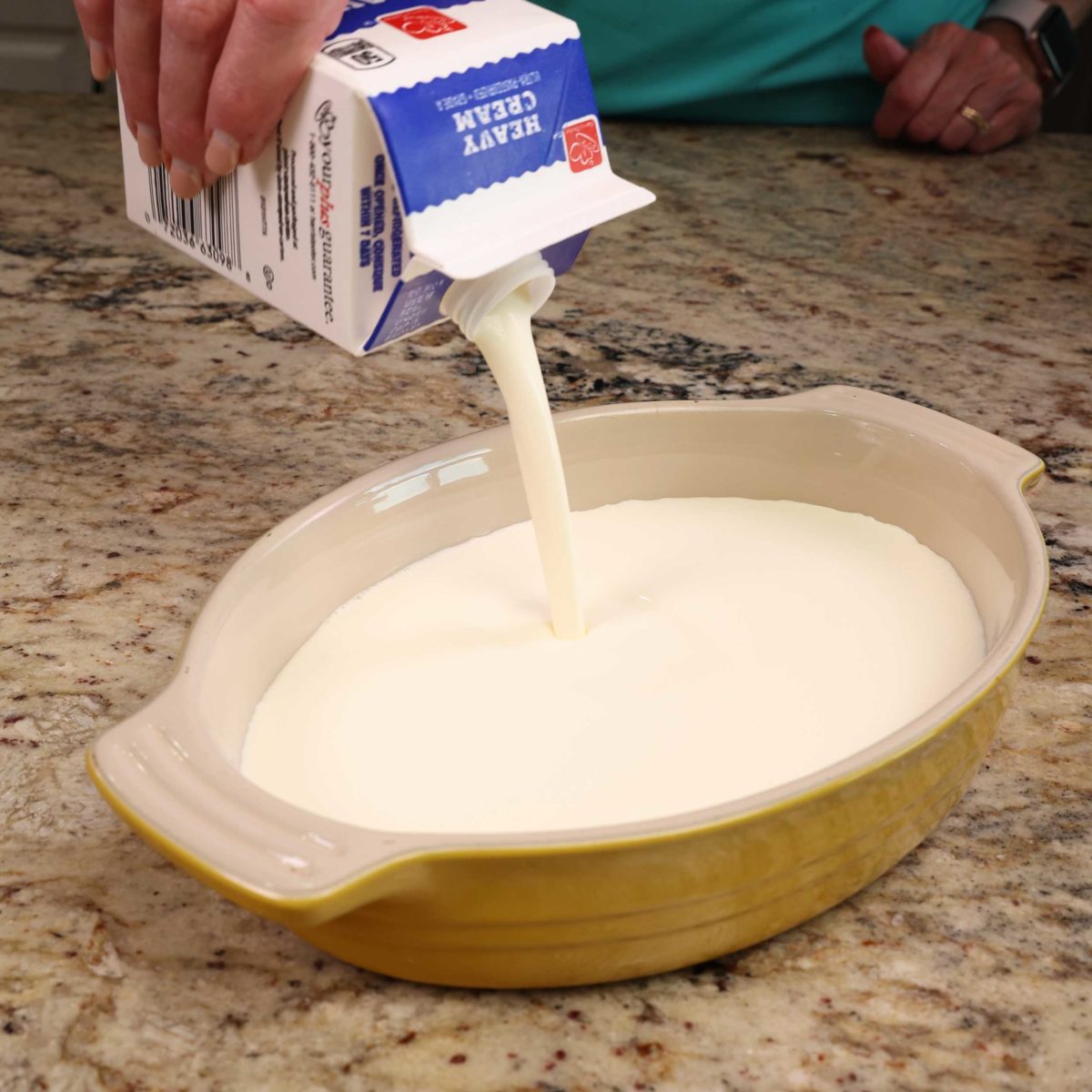
- Remove from the oven. A yellowish layer will have formed on top—that’s your clotted cream.
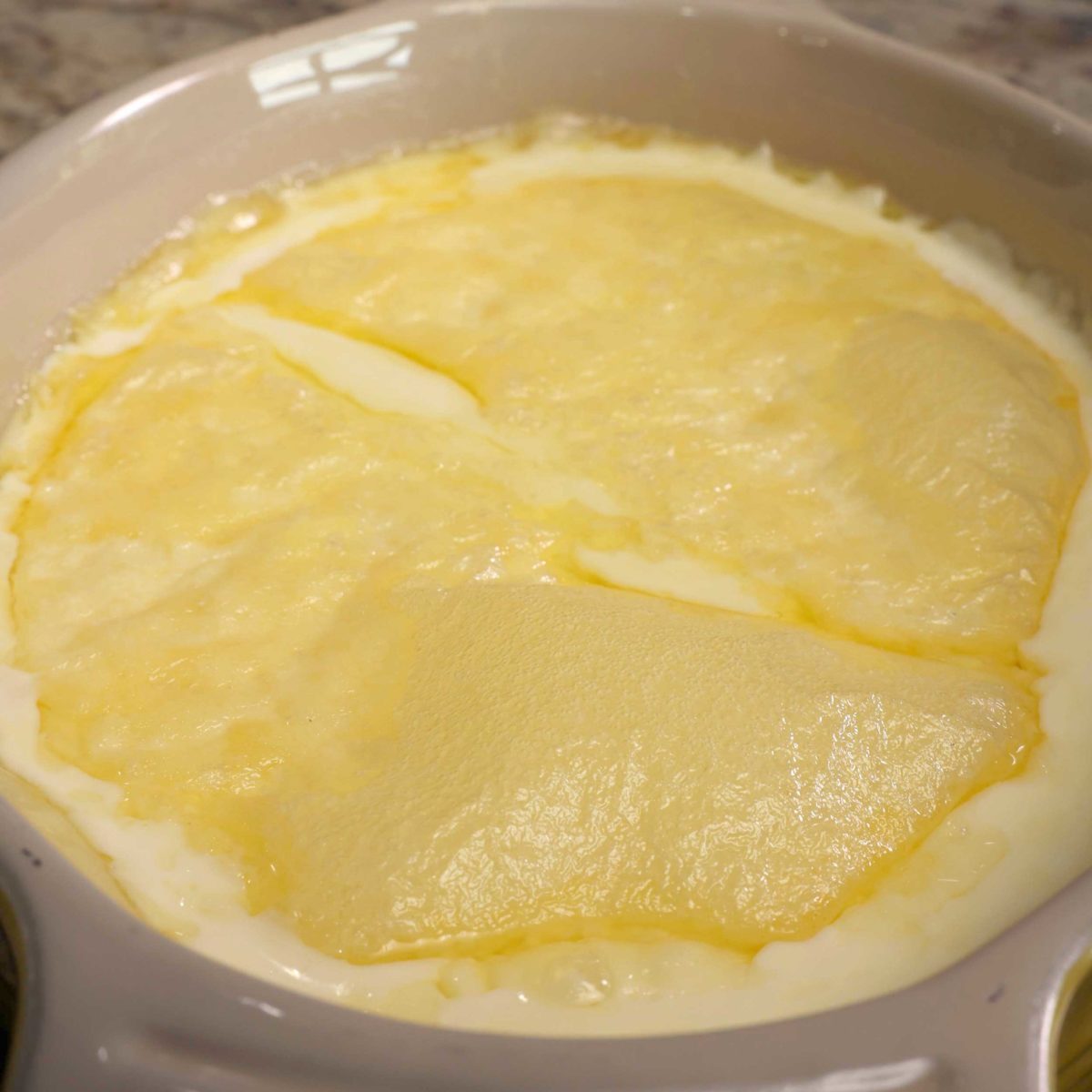
- Cool at room temperature, then cover and refrigerate for at least 12 hours to set.
- Scoop out the clotted cream. Use a spoon to transfer the thick, buttery cream into a jar, leaving the liquid (whey) behind. This whey is great for baking scones.
The finished clotted cream will have a rich, creamy texture, similar to crème fraîche but even smoother and slightly sweet. You can enjoy it as is or stir it for a lighter consistency.
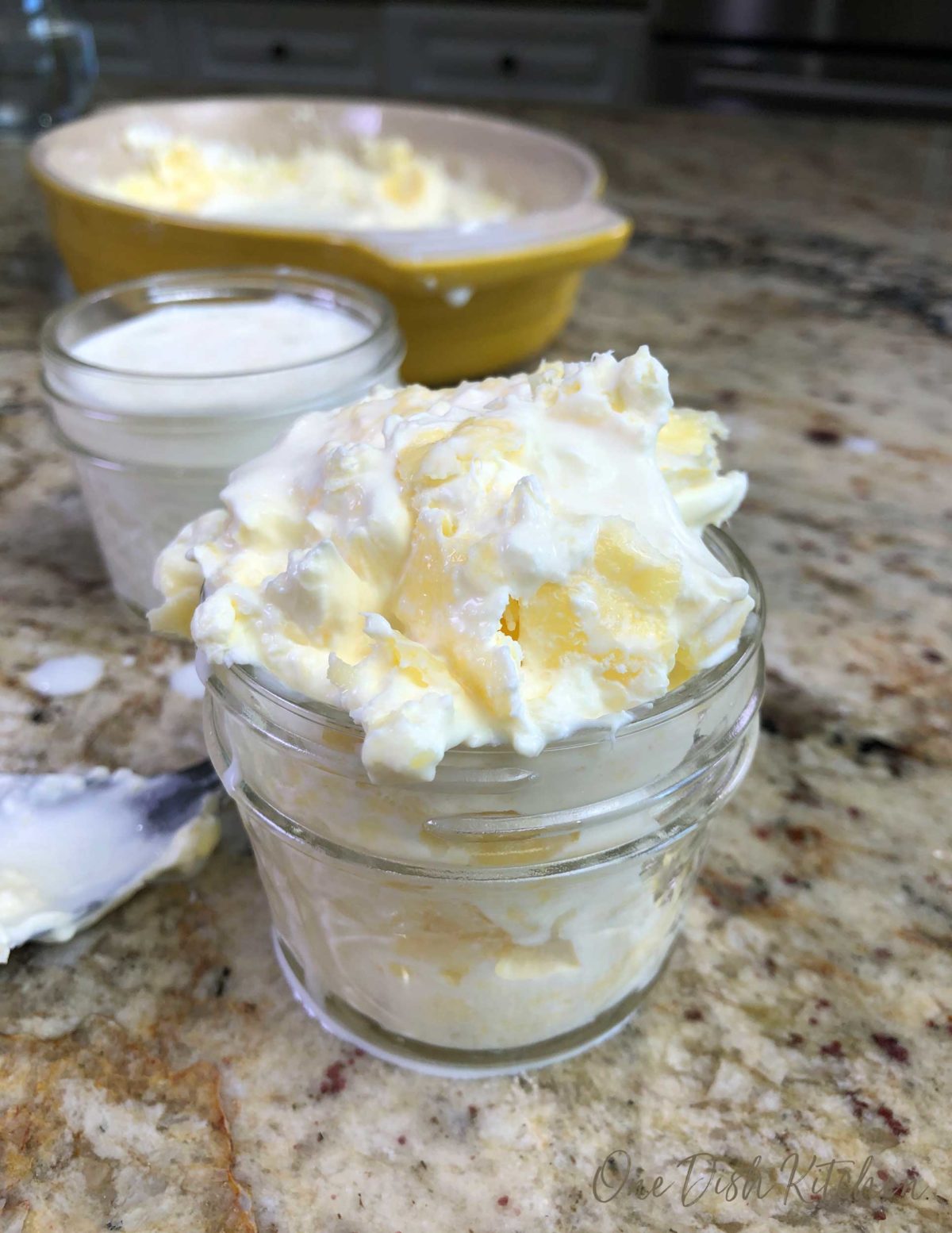
Yields 1 cup of clotted cream.
Expert Tips
- Check your oven settings. Some ovens have an auto shut-off feature. If yours does, set an alarm to turn it back on so the cream bakes for the full 12 hours.
- Making more? Use a larger dish. This recipe doubles easily, but you’ll need a bigger dish, like a 9×13-inch baking pan, to ensure even heating.
- Save the leftover liquid. The whey left in the dish after making clotted cream is great for baking—especially in scones. Use it as a substitute for milk in recipes.
What To Serve With Clotted Cream
Homemade clotted cream is rich, creamy, and surprisingly versatile. Try it with:
- Spread it on warm cream cones with our refrigerator jam for a classic cream tea.
- Add a spoonful to single serving pancakes or waffle for one for a rich breakfast or brunch.
- Top fresh berries with clotted cream and a drizzle of honey or maple syrup.
- Stir into hot coffee for a smooth, velvety finish.
- Serve over small batch baked apples for a warm and creamy dessert.
Frequently Asked Questions
This can happen if the cream wasn’t baked long enough or didn’t have enough fat content. Make sure you’re using heavy cream (not light cream or half-and-half) and that the oven maintained a low, steady temperature.
No, do not stir the cream. The goal is to let the fats rise and form clots undisturbed.
Stored in an airtight container in the refrigerator, homemade clotted cream lasts up to 5 days.
The leftover liquid is great for baking scones, pancakes, or adding to soups and sauces as a milk substitute.
Ways To Use Leftover Ingredients
If you have any ingredients leftover from this recipe, check out our Leftover Ingredients Recipe Finder or you might like to consider using them in any of these single serving and small batch recipes:
If you’ve tried this small batch clotted cream or any recipe on One Dish Kitchen please let me know how you liked it by rating the recipe and telling me about it in the comment section below.
Also, if you take a picture please tag us on Instagram (@onedishkitchen) we’d love to see!
Small Batch Clotted Cream

Equipment
- 6×8 inch baking dish or a 5×7 inch baking dish
Ingredients
- 1 pint heavy cream (2 cups) Pasteurized cream is preferred but ultra-pasteurized can work in a pinch. See notes below.
Instructions
- Preheat the oven to 175°F (80°C). Pour the heavy cream into a 6×8 or a 5×7-inch baking dish and place it in the oven. Bake for 12 hours—this works well overnight.Important: Some ovens shut off automatically after several hours. Check your manual and set an alarm if needed.
- Remove from the oven. A yellowish layer will have formed on top—that’s your clotted cream.
- Cool at room temperature, then cover and refrigerate for at least 12 hours to set.
- Scoop out the clotted cream. Use a spoon to transfer the thick, buttery cream into a jar, leaving the liquid (whey) behind. This whey is great for baking scones or biscuits.
- The finished clotted cream will have a rich, creamy texture, similar to crème fraîche but even smoother and slightly sweet. You can enjoy it as is or stir it for a lighter consistency.
Notes
-
- Check your oven settings. Some ovens have an auto shut-off feature. If yours does, set an alarm to turn it back on so the cream bakes for the full 12 hours.
-
- Making more? Use a larger dish. This recipe doubles easily, but you’ll need a bigger dish, like a 9×13-inch baking pan, to ensure even heating.
-
- Save the leftover liquid. The whey left in the dish after making clotted cream is great for baking—especially in scones. Use it as a substitute for milk in recipes.
- Heavy Cream: The only ingredient needed for homemade clotted cream. While most recipes call for regular pasteurized cream, it’s not always easy to find. We tested both pasteurized and ultra-pasteurized cream, and both work—though with slight differences.
- Pasteurized Heavy Cream (Preferred): This cream undergoes minimal processing, allowing better curd formation. If available, it’s the best choice.
- Ultra-Pasteurized Heavy Cream (Works Too): This cream is heated to a higher temperature for a longer shelf life. It still produces clotted cream, though the curds may not separate as distinctly.
Nutrition
The information shown is an estimate provided by an online nutrition calculator. It should not be considered a substitute for a professional nutritionist’s advice.
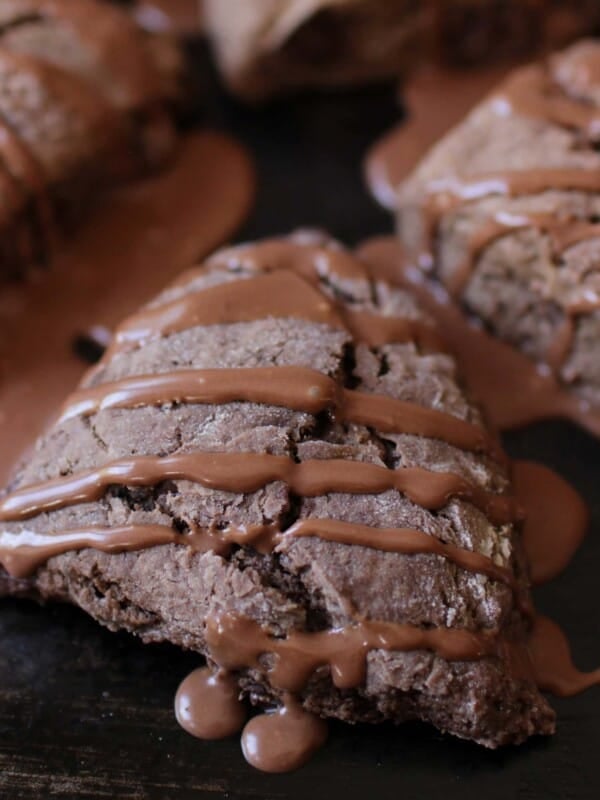

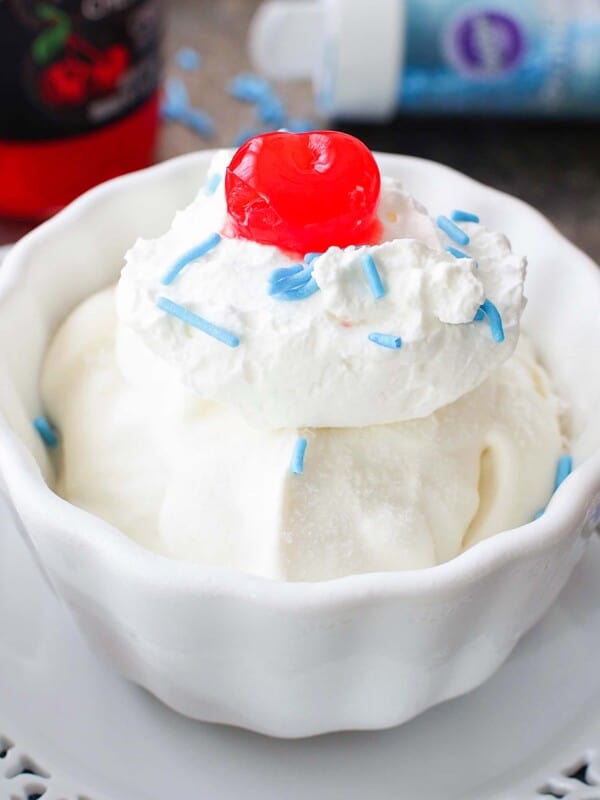
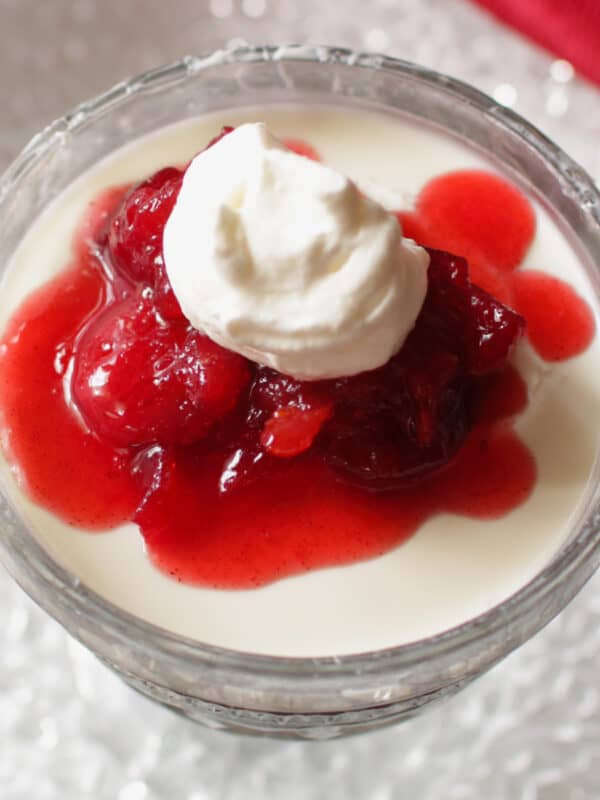


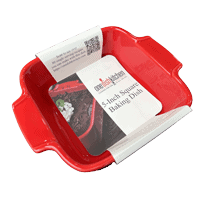










Can I use the leftover liquid to make a second batch of clotted cream?
No. I like to use the leftover liquid from the clotted cream to make scones or biscuits.
Used ultra-pasteurized cream and was delighted with the results. I will never buy an overpriced jar again! $7.99 for a small jar at World Market and online. I got 4x as much cream from the recipe, and it cost me about $1.50. Thank you very much!
Tried it for the Queen’s Platinum Jubilee with great success! Mine was a little thick so had to stir in some of the liquid but otherwise tastes great and can’t wait to try it on scones I’m baking this week.
I have made clotted cream using these exact same instructions from various sites. I also have found that you can use ultra pasteurized with virtually the same results. Most photos show the cream to be snowy white. You show yours to be more yellow. However I have made it covered and uncovered and it still comes out with a golden brown crust on top instead of yellow. I have actually checked it after only 4 hours and it is yellow but I left it in the oven for the full 12 hours. I have taken it out after 10 hours but it’s still more browned on top.My oven’s lowest setting is 180. It doesn’t make for a pretty cream like most recipe photos depict but it tastes good. Actually the crust is the tastiest part. Yesterday I made a stovetop version which took less than an hour. It is creamier and whiter and is pretty good but doesn’t have that slight caramelized flavor .
My ovens lowest temperature is 200. Does this effect and reduce the cooking time because it is hotter? or will it still work at 200 degrees?
Hi Bayley, my concern would be that the cream won’t clot properly. However, if you’d like to try it check your cream after 10 hours instead of 12 hours.
I would love to make this clotted cream, my oven only goes to 200 Fahrenheit I wouldn’t normally worry but it’s in the oven for 12 hours is this possible for me to make this recipe?
Yes, you can still make this recipe since the oven heats to 175 F.
Thank you for your lovely recipes, Joanie.
For this recipe, can I freeze the left over cream and re-use it?
I am from South Africa.
Minnie
I’m so glad you are enjoying our recipes, Minnie. Yes, clotted cream can be frozen in an airtight container for up to 3 months.
I’m a little confused. I live in Quebec, Canada. We generally have 3 kinds of cream here. 10% milk fat is used as coffee cream, 15% milk fat is usually used for cooking, and 35% is called whipping cream. Which of these should I use for this recipe?
Use the one with the highest fat which would be whipping cream.
Omg! It worked with ultrapasturized cream. Delish, now onto making some cream scones to go with it! Thanks!
I have found clotted cream in the refrigerated section at Whole Foods but as you said — it’s rather pricey. I have had tea at Fortnum & Masons and a pre-theater tea at The Savoy. My favorite tea room in London is Maids of Honor, near Kew Gardens. They have the best meat pies!